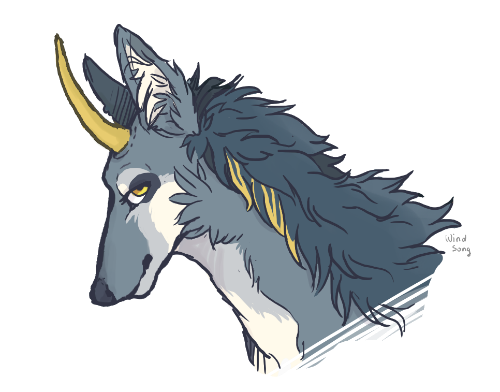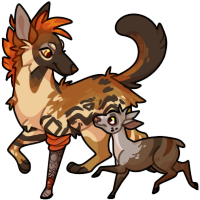W E L C O M E
Cadelornes (Canis Cadelus)
- cah - deh - lorn - ehs -
|| Fanclub || Ask || Archive ||

BASIC INFO
Cadelornes are the only species belonging to the Canis Cadelus family and so are treasured and protected by ''no hunting'' laws. Despite having always been wild and distant animals, deforestation and pollution have driven these creatures to settle in more urban areas with some human contact. The number of domesticated cadelornes is increasing rapidly, and while none have been fully tamed or ridden yet, it's a possibility for the future.
They're most commonly found in environments covered by dense forests, often relieved by sources of water such as ponds or swamps and clearings of lush meadows. Freshwater swamp forests and Mixed broadleaf/needleleaf forests provide ideal conditions for these mammals. Their diet includes roots that are easily dug up with the sharp single horn, berries, common plants and in certain conditions small fish.
Physically, cades can come in any range of color or pattern, though extremely bright cadelornes do not exist, i.e. neon colors are unacceptable, while bright shades and accents aren't rare. Natural colors found in their habitat are the most common and help cades survive, as despite their size and speed, they may be prey to packs of wolves or large wild cats. There are many unknown exceptions to their coats and colors however as one can never be certain of what secrets the cadelorn species holds.
SPECIFICS
Species Name - Cadelornes
single - cadelorn (one cadelorn / the cadelorn's horn) short: cade
plural - cadelornes (two cadelornes/ the cadelornes' horns) short: cades
Both male and female cadelornes can be referred to as a cadelorn or cade,
however female cades who have given birth at least once in their life can also be called Dells (single: dell),
and male cades over the age of 10 or male cades who have at least one offspring can be called Lores (single: lore).
Cadelornes under the age of 5 can be referred to as Laurels (single: laurel).
Most cadelornes reach the age of 60, while the oldest recorded cade lived to 98 years.
A cade is fully grown at the age of 10, and the 'teenage years' usually occur between 6 and 9 years of age.
A female cadelorn will usually bear a single laurel, after a gestation period of approximately 10 months. Young laurels are able to walk within an hour of birth.
Cadelornes (Canis Cadelus)
- cah - deh - lorn - ehs -
|| Fanclub || Ask || Archive ||

The cadelornes species is a distinct hybrid mammal from which many genera have decended. They share close characteristics with the Ethiopian wolf, the common equine and are recognised by their single horn, which is similar in structure to that of the hippotragus family. They are an extremely old species who have also had influence on myths and common preconceptions. It's believed creatures such as the unicorn, the quilin and the amarok have all evolved from glimpses of the shy cadelorn, developing into legends we recall today.
BASIC INFO
Cadelornes are the only species belonging to the Canis Cadelus family and so are treasured and protected by ''no hunting'' laws. Despite having always been wild and distant animals, deforestation and pollution have driven these creatures to settle in more urban areas with some human contact. The number of domesticated cadelornes is increasing rapidly, and while none have been fully tamed or ridden yet, it's a possibility for the future.
They're most commonly found in environments covered by dense forests, often relieved by sources of water such as ponds or swamps and clearings of lush meadows. Freshwater swamp forests and Mixed broadleaf/needleleaf forests provide ideal conditions for these mammals. Their diet includes roots that are easily dug up with the sharp single horn, berries, common plants and in certain conditions small fish.
Physically, cades can come in any range of color or pattern, though extremely bright cadelornes do not exist, i.e. neon colors are unacceptable, while bright shades and accents aren't rare. Natural colors found in their habitat are the most common and help cades survive, as despite their size and speed, they may be prey to packs of wolves or large wild cats. There are many unknown exceptions to their coats and colors however as one can never be certain of what secrets the cadelorn species holds.
SPECIFICS
Species Name - Cadelornes
single - cadelorn (one cadelorn / the cadelorn's horn) short: cade
plural - cadelornes (two cadelornes/ the cadelornes' horns) short: cades
Both male and female cadelornes can be referred to as a cadelorn or cade,
however female cades who have given birth at least once in their life can also be called Dells (single: dell),
and male cades over the age of 10 or male cades who have at least one offspring can be called Lores (single: lore).
Cadelornes under the age of 5 can be referred to as Laurels (single: laurel).
Most cadelornes reach the age of 60, while the oldest recorded cade lived to 98 years.
A cade is fully grown at the age of 10, and the 'teenage years' usually occur between 6 and 9 years of age.
A female cadelorn will usually bear a single laurel, after a gestation period of approximately 10 months. Young laurels are able to walk within an hour of birth.
UNCOMMON FEATURES
Some Cadelornes may present rarer
features or mutations, which may be
influenced by their habitat, genetics
or general survival conditions
that result in certain adaptations.
These may include;
-cloven hooves
-twisted / elongated / shorter horn
-extra horn(s)
-heterochromia
-longer / shorter mane and tail
Along with many unknown mutations that have
not yet been discovered, or have been noted in
very few cadelornes.
SIZES
Newborn; newborn fawn - average foal
Adolescent; larger pony - fallow deer
Adult; common elk - shire horse












 ✧
✧  ✧
✧ 

